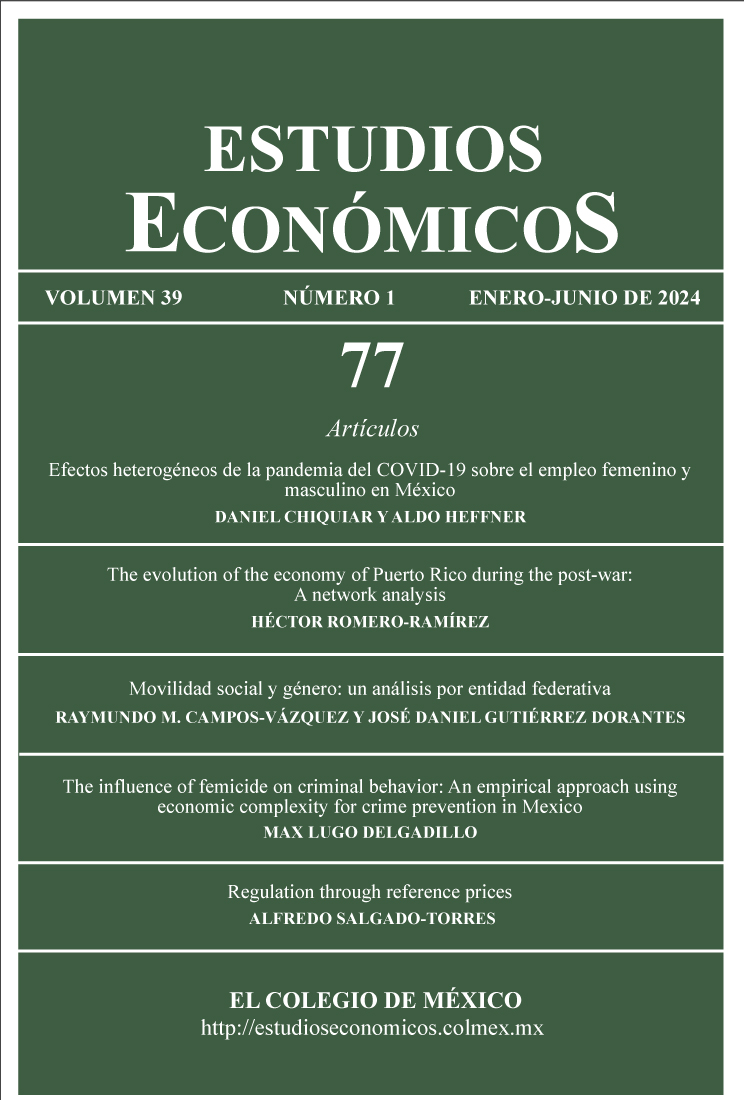
Published 2024-02-19
Keywords
- regulation,
- reference prices,
- welfare gains
How to Cite
Salgado-Torres, A. (2024). Regulation through reference prices. Estudios Económicos De El Colegio De México, 39(1), 159–201. https://doi.org/10.24201/ee.v39i1.450
Abstract
We analyze the role of reference prices on competition and welfare in a circular city model where paying prices above a reference negatively affects consumers' utility. Agents interact in a three-stage game. First, a policymaker chooses a reference price; second, firms make their entry decision; finally, firms compete in prices while consumers make their consumption decisions. We find that the market price and the optimal reference price always coincide in equilibrium, reducing consumer prices and implying a net welfare gain.
Downloads
Download data is not yet available.
References
- Birg, L. 2015. Pharmaceutical regulation, mandatory substitution, and generic competition, Discussion Paper No. 241, Center for European, Governance and Development Research, Georg-August-Universität Göttingen. DOI: https://doi.org/10.2139/ssrn.2599264
- Brekke, K., C. Canta, and O. Straume. 2016. Reference pricing with endogenous generic entry, Journal of Health Economics, 50: 312-329. DOI: https://doi.org/10.1016/j.jhealeco.2016.04.003
- Brekke, K., A. Grasdal, and T. Holmas. 2009. Regulation and pricing of pharmaceuticals: Reference pricing or price cap regulation?, European Economic Review, 53: 170-185. DOI: https://doi.org/10.1016/j.euroecorev.2008.03.004
- Brekke, K., T. Holmas, and O. Straume. 2011. Reference pricing, competition, and pharmaceutical expenditures: Theory and evidence from a natural experiment, Journal of Public Economics, 95(7-8): 624-638. DOI: https://doi.org/10.1016/j.jpubeco.2010.11.015
- Chenavaz, R. 2016. Dynamic pricing with reference price dependence, Economics Discussion Paper No. 2016-20, Kiel Institute for the World Economy. DOI: https://doi.org/10.5018/economics-ejournal.ja.2016-22
- Kaiser, U., S. Mendez, and H. Ullrich. 2014. Regulation of pharmaceutical prices: Evidence from a reference price reform in Denmark, Journal of Health Economics, 36: 174-187. DOI: https://doi.org/10.1016/j.jhealeco.2014.04.003
- Koschate-Fischer, N. and K. Wullner. 2017. New developments in behavioral pricing research, Journal of Business Economics, 87: 809-875. DOI: https://doi.org/10.1007/s11573-016-0839-z
- Miraldo, M. 2009. Reference pricing and firms’ pricing strategies, Journal of Health Economics, 28: 176-177. DOI: https://doi.org/10.1016/j.jhealeco.2008.09.006
- Popescu, I. and Y. Wu. 2007. Dynamic pricing strategies with reference effects, Operations Research, 55(3): 413-429. DOI: https://doi.org/10.1287/opre.1070.0393
- Putler, D. 1992. Incorporating reference price effects into a theory of consumer choice, Marketing Science, 11(3): 287-309. DOI: https://doi.org/10.1287/mksc.11.3.287
- Salop, S. 1979. monopolistic competition with outside goods, The Bell Journal of Economics, 10(1): 141-156. DOI: https://doi.org/10.2307/3003323
- Zhou, J. 2011. Reference dependence and market competition, Journal of Economics and Management Strategy, 20(4): 1073-1097. DOI: https://doi.org/10.1111/j.1530-9134.2011.00309.x
